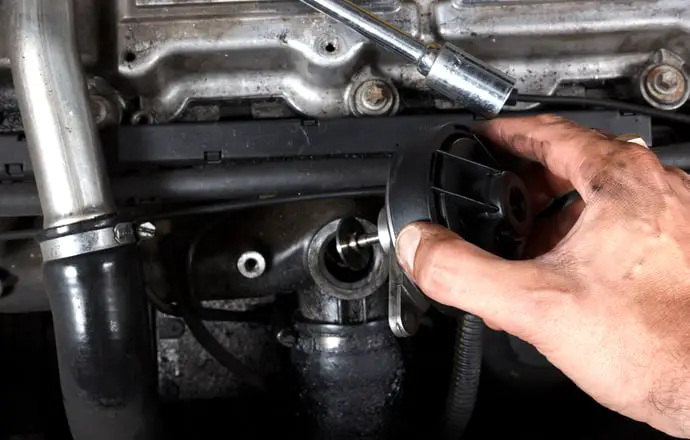Last Updated on August 19, 2022 by

Few things are more important as an auto owner than knowing how your engine works. You may not be a mechanic, but you never know when you’re going to have to play one in the event of an unexpected auto incident. While you can always hope to contact a professional mechanic, and while MOT tests can pick out lots of prospective engine issues before they become real problems, you may not always have that luxury. If you are stranded on the side of the road and need to get your car up and running by yourself, it helps to know how vital components like your EGR valve work.
Besides, trips to a local garage can start to add up.
To help you save money and solve some common engine issues, therefore, let’s take a deeper look at one of your engine’s most important parts, the exhaust gas reticulation valve, and see what it does and how to fix it should the need arise.
EGR 101
First things first – what exactly is an EGR valve, how does it work, and why is it so important?
Your EGR is tasked with recirculating your engine’s emissions. This can help cut down on noxious exhaust while also making your engine more fuel efficient. In addition, expelling exhaust into the air is harmful for the environment, which is why emission standards are strictly controlled according to MOT regulations. Instead, your EGR works to return these gasses to your engine’s combustion chamber.
In the face of global warming and climate change, we are all encouraged to “reduce, reuse, and recycle,” and this method fits right in with that. Your EGR allows you to reduce your emissions, reuse the gas, and recycle them into something which is fuel-efficient and more environmentally-friendly.
Conversely, cars which have a faulty EGR are smog and emissions hazards. You don’t want to get dirty looks owing to your vehicle emitting foul clouds of black smoke, and you certainly don’t want to be penalised with fines as a result. As such, having a working EGR is essential, especially for vehicles with diesel engines.
When you start your engine, the EGR valve is on standby, ready to deal with the would-be exhaust when it reaches the right temperature, which is usually set to around 2500 degrees Celsius. Once that temperature is reached, the EGR gradually opens, diverting the airflow of would-be exhaust back into the chamber.
If something obstructs the EGR, or the airflow is otherwise blocked, your vehicle may start to suffer smog and combustion issues which can lead to performance problems as well as emissions issues.
Signs of an EGR Valve Issue
The first step toward fixing a problem is knowing you have one. That’s true of psychological issues, and it’s true of automotive ones as well. In either case, in order to be able to identify your problem, you first have to know what to look for. Some of the most common signs that your EGR valve may be in trouble include the following:
- Foul Odours: Exhaust isn’t always the most pleasant of aromas, and the EGR valve is tasked with keeping it to a minimum. If your vehicle starts to give off heavy odiferous clouds of smog, chances are you have an exhaust problem, which may well be due to your EGR.
- Poor Performance: Your engine’s combustion system requires a very delicate balance to work. Any small unauthorised tweak could throw it off, and that includes EGR issues. If your vehicle suddenly starts to have problems accelerating or becomes less fuel efficient and requires refills at petrol stations more frequently than usual, an EGR issue may be at least partly to blame.
- Check Engine Light: Modern cars have a “check engine” light which will flick on if there is an issue, including with your EGR. For example, if your EGR does not close properly, your vehicle’s onboard computer should detect the problem and trigger the “check engine” light.
- Failed MOT Tests: If your car fails its emissions test as part of an MOT inspection, one potential reason may be difficulties with your EGR. If this is the case, the mechanic conducting the test should let you know.
- Idling Issues: When your car is idling, it should operate smoothly. If it does not, and instead feels rough and gives you a bumpy ride even when your car isn’t in motion, the culprit may be an excess of exhaust gases bouncing around in the combustion chamber, which in turn can indicate that your EGR is failing to regulate their intake and expulsion.
Potential Causes and Fixes
Why has your EGR run into problems?
Some potential reasons may include the following:
- Valve Sticking: As noted, your EGR works by opening and closing as needed to regulate the flow of air between your combustion and exhaust systems. If the EGR becomes stuck, it may only allow air into the combustion engine or only let it flow out again. This in turn can cause your vehicle to run less smoothly, causing that aforementioned rough idling. A valve cleaning kit may be required to resolve this issue. Remove the cap and clean the inside with carbon cleaner.
- Valve Closed: Alternatively, your EGR may be stuck in the closed position. If your car has an onboard computer, error codes P1406 and P1404 can indicate this issue. If you hear a knocking sound emanating from your engine, this too may be a sign of this EGR issue. If this is the case, you’ll have to manually open the valve and clear away any debris.
- Clogging: One of the most common causes of issues in diesel engines is clogging. If this is the case, you’ll need to clear out the source of the clog.
If your car continues to suffer from EGR issues, or the problem worsens, you should take it to a professional garage for further diagnosis and treatment.
However, hopefully with this overview you will be better armed to diagnose and treat EGR issues yourself, helping you get back on the road that much more quickly.
